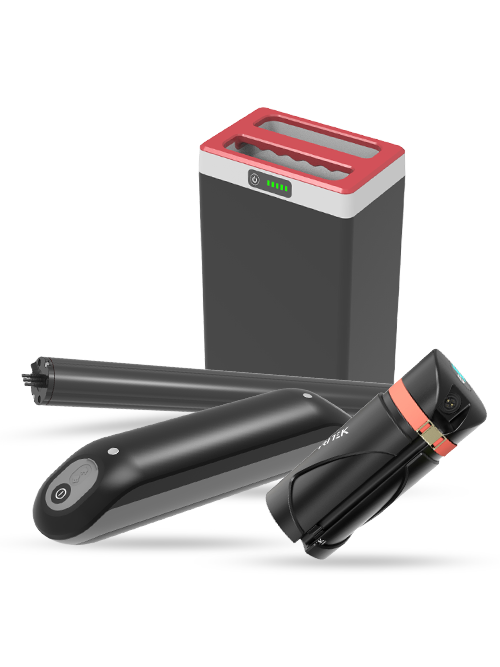Introduction
E-bikes have gained immense popularity in recent years, offering a convenient and eco-friendly mode of transportation. However, with the rising demand for electric bikes, it becomes crucial to address safety concerns, particularly the risks associated with e-bike’s battery overheating. Ensuring proper safeguards and preventive measures can help mitigate these risks and ensure a safe riding experience.

In this article, we will explore the potential dangers of e-bike battery overheating and provide valuable insights and tips on how to safeguard against these risks.
We also have a guide to winter-proof e-bike batteries if you’re interested.
Understanding E-bike’s Battery Overheating Risks
Electric bike batteries, typically lithium-ion batteries, are susceptible to overheating due to various factors. Understanding the causes and consequences of battery overheating is essential for ensuring rider safety. Let’s delve into the key aspects associated with this concern.
Factors Contributing to E-bike’s Battery Overheating
There are several factors that can contribute to e-bike battery overheating. It is important to be aware of these factors in order to effectively mitigate the risks. Some of the common contributors include:
- High Ambient Temperatures: Extreme weather conditions, especially hot climates, can significantly increase the chances of battery overheating. When exposed to high temperatures, the battery overheats and its internal temperature rises, potentially leading to malfunctions and safety hazards.
- Overcharging: Overcharging the e-bike battery can cause excessive heat buildup and increase the risk of overheating. It is crucial to follow the manufacturer’s guidelines and use the recommended chargers to prevent overcharging.
- Mechanical Damage: Physical damage to the battery, such as impacts or punctures, can compromise its internal structure and insulation. This damage can lead to the release of heat and potentially result in battery overheating.
- Improper Storage: Storing the e-bike or its battery in environments with extreme temperatures or high humidity levels can impact the batteries stored performance and increase the likelihood of overheating.




Consequences of E-bike Battery’s Overheating
Battery overheating can have severe consequences, ranging from reduced performance to safety hazards. It is crucial to understand the potential outcomes associated with battery overheating. Here are some of the consequences to be aware of:
- Reduced Battery Life: Continuous exposure to high temperatures can significantly shorten the lifespan of the e-bike battery. Overheating accelerates chemical reactions within the battery, leading to premature degradation and reduced overall capacity.
- Performance Degradation: Overheating can impact the performance of the e-bike, resulting in reduced power output and limited range. This can undermine the overall riding experience and convenience offered by e-bikes.
- Safety Hazards: In extreme cases, battery overheating can lead to safety hazards such as fires or explosions. Although such incidents are rare, they highlight the importance of implementing preventive measures to safeguard against overheating risks and mitigate the potential fire hazard.
Tips for Safeguarding Against E-bike Battery Overheating
Now that we understand the risks associated with e-bike battery overheating, let’s explore some effective tips to help mitigate these risks and ensure a safe riding experience.
1. Regularly Inspect the Battery
It is crucial to regularly perform inspections of the e-bike battery to identify any signs of physical damage, such as dents or cracks. Inspect the battery casing, connectors, and wiring to ensure everything is intact. If you notice any abnormalities or a faulty battery, it is advisable to seek professional assistance or replace the battery regularly.
2. Proper Charging Practices
Follow the manufacturer’s guidelines regarding charging the e-bike battery. Avoid using chargers that are not recommended or supplied by the manufacturer, as they may not have the necessary safety features. Additionally, avoid overcharging the battery and disconnect it from the charger once it reaches full capacity.
3. Optimal Storage Conditions
When storing your e-bike or its battery, it is important to avoid storing it in areas exposed to direct sunlight or extreme temperatures. To prevent potential overheating, ensure that your e-bike or its battery is kept in a cool, dry place. Extreme heat or cold can have adverse effects on the battery’s performance and increase the risk of overheating.
4. Avoid Overexertion
Pushing your e-bike beyond its limits can put excessive strain on the battery, leading to overheating. Avoid continuously riding at maximum power settings or attempting steep inclines for extended periods. Allow the battery to cool down periodically during longer rides.
5. Install Heat Dissipation Features
Consider installing additional heat dissipation features, such as cooling fans or heat sinks, to help regulate the temperature of the e-bike battery. These aftermarket additions can aid in dissipating heat and reduce the risk of overheating.
6. Monitor Battery Temperature
Some advanced e-bike models offer temperature monitoring features. Keep an eye on the battery’s temperature during rides and take necessary breaks if it exceeds safe levels. This can help prevent overheating and ensure a longer battery life.
Explore 5 Benefits of BMS battery for E-Bikes
FAQs About E-bike’s Battery Overheating
FAQ 1: What should I do if I notice my e-bike battery overheating?
If you notice your e-bike battery overheating, immediately stop using the bike and disconnect the battery. Allow it to cool down in a well-ventilated area before inspecting for any damage. If the overheating persists or you notice any signs of physical damage, consult a professional for assistance.
FAQ 2: Can I ride my e-bike in hot weather without worrying about battery overheating?
While e-bikes are designed to withstand various weather conditions, it is important to exercise caution in hot weather. High temperatures can increase the risk of battery overheating. Ensure proper cooling and follow the recommended guidelines for operating the e-bike in hot climates.
FAQ 3: Are there any specific battery brands or models known for their resistance to overheating?
Different e-bike battery brands and models have varying degrees of resistance to overheating. It is advisable to research and choose reputable brands that prioritize safety and utilize advanced battery management system (BMS) to regulate temperature and prevent overheating.
Tritek’s battery is intergrated with intelligent BMS to prvent battery from overcharge, over-discharge, short circuit, etc.
FAQ 4: Are there any warning signs that indicate my e-bike battery is overheating?
Yes, there are some warning signs to watch out for. If you notice excessive heat emanating from the battery, a sudden decrease in performance or range, or unusual smells, it could indicate battery overheating. If you experience any of these signs, take immediate action and ensure your safety.
FAQ 5: Can I replace the battery of my e-bike myself?
Replacing the battery of an e-bike can be a complex task and may require technical expertise. It is recommended to consult the manufacturer or a professional technician to ensure the correct installation and compatibility of the new battery. Mishandling or using incompatible batteries can lead to safety risks.
FAQ 6: How often should I service my e-bike battery to prevent overheating risks?
Regular servicing of your e-bike battery is essential to maintain its performance and safety. It is recommended to follow the manufacturer’s guidelines for servicing intervals and consult a professional if you notice any abnormalities or experience concerns regarding battery overheating.
Conclusion
Safeguarding against e-bike battery overheating risks is crucial to ensure rider safety and prolong battery life.
By understanding the factors that contribute to overheating, following proper charging practices, and implementing preventative measures, you can mitigate the risks associated with e-bike battery overheating. Remember to regularly inspect your battery, monitor its temperature, and seek professional assistance when needed. Ride safely and enjoy the convenience and eco-friendliness of your e-bike.
About Tritek
We are a trusted manufacturer of integrated BMS lithium-ion battery packs located in Shenzhen, China. Our company has over 15 years of experience in research and development, manufacturing, and sales of high-quality batteries for e-bikes. We pride ourselves on producing compact and lightweight battery packs with exceptional output performance.
At Tritek, we have a team of more than 100 experienced R&D personnel dedicated to ensuring the safety and reliability of our products. We follow strict quality systems and hold international certifications, including CE, FCC, UL2271, and EN15194. Our commitment to excellence is reflected in our strong production capacity, prompt delivery, and comprehensive after-sales service.
To provide the best customer experience, we have established after-sales service centers in Spain and Germany, and are in the process of expanding to the United States. We aim to cater to the diverse needs of our clients and ensure their satisfaction with our products and services.
Choose Tritek for superior e-bike battery solutions that prioritize safety, performance, and durability. Contact us for more information and to explore our wide range of lithium-ion battery packs.
Experience the Tritek difference today and ride with confidence!



